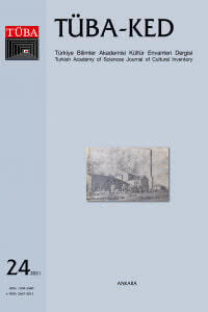MÜBADELE VE KONUT BAĞLAMINDA MERSIN İHSANİYE MAHALLESİ
THE CONTEXT OF IMMIGRANTS AND HOUSING: THE ıHSANıYE NEIGHBOURHOOD OF MERSıN
Immigration, Crete, identity, housing.,
___
- Arı, O., 1960. Bulgaristanlı Göçmenlerin İntibakı, 1950-51'de Bursa 'ya İstanbul'da İskân Edilenlerin İntibakı İle İlgili Sosyolojik Araştırma. Rekor Matbaası, Ankara.
- Artan, G., 2003. Mersin Tarihi Kronolojisi. İçel Sanat Kulübü Yayını, Mersin.
- Belli, M., 2004. Türkiye - Yunanistan Nüfus Mübadelesi; Ekonomik Açıdan Bir Bakış. Belge Yayınları, İstanbul.
- Cengizkan, A., 2004. Mübadele Konut ve Yerleşimleri. Arkadaş Yayıncılık Ltd., Ankara.
- Gökaçtı, M. A., 2005. Nüfus Mübadelesi; Kayıp Bir Kuşağın Hikayesi. İletişim Yayınları, İstanbul.
- Koufopoulou, S., 2005. Ege'yi Geçerken, 1923 Türk-Yunan Zorunlu Nüfus Mübadelesi (Crossing the Aegean, An appraisal of the 1923 compulsory population Exchange between Greece and Turkey). İstanbul Bilgi Üniversitesi Yayın¬ ları 95, İstanbul.
- Milas, H., 2002 (der.). Göç, Rumların Anadolu'dan Mecburi Ayrılışı (1919-1923). Küçük Asya Araştırmaları Merkezi, İle¬ tişim Yayınları, İstanbul.
- http://www.giritturk.com/giritli-mubadillerde-kimlikolusumu-t1703.html (2008)
- http://www.balgoc.org.tr/gocmenyerlesim.html (2008)
- ISSN: 1304-2440
- Yayın Aralığı: 2
- Başlangıç: 2003
- Yayıncı: Türkiye Bilimler Akademisi
ADANA KENTSEL KÜLTÜR VARLIKLARI ENVANTERİ 2004 - 2005
İpek DURUKAN, Figen KARAMAN, Duygu SABAN, Onur ERMAN
İSTANBUL'DA BİR ENDÜSTRİYEL MİRAS ÖRNEĞİ: BOMONTİ BİRA FABRİKASI
SOMUT OLMAYAN KÜLTÜREL MİRAS ENVANTERİ
KENTSEL KÜLTÜR VARLIKLARININ DEĞERLENDİRİLMESİNE VE TANITILMASINA YÖNELİK BİR ÖNERİ: BULDAN ÖRNEĞİ
TALAS KAYSERİ KENTSEL KÜLTÜR VARLIKLARI ENVANTERİ 2007 - 2009
Gonca BÜYÜKMIHÇI, Neşe Yılmaz BAKIR, Hikmet ELDEK
MÜBADELE VE KONUT BAĞLAMINDA MERSIN İHSANİYE MAHALLESİ
OSMANİYE ARKEOLOJİK KÜLTÜR VARLIKLARI ENVANTERİ ÇALIŞMASI 2007-2008
ILISU BARAJI İNŞAAT SAHASI YÜZEY ARAŞTIRMASINDA BELİRLENEN ARKEOLOJİK ALANLAR
A. Tuba ÖKSE, Ahmet GÖRMÜŞ, Erkan ATAY, Yunus MULUK, Murat EROĞLU, Sibel TORPİL, Aziz Ayhan BAYRAKTAR, Yeliz TAN, Nur Balkan ATLI, Laurence ASTRUC, Nurcan KAYACAN
BOYABAT'IN GELENEKSEL MİMARİSİNDE DEĞİRMENLER VE ŞAMLILAR ÇELTİK FABRİKASI
